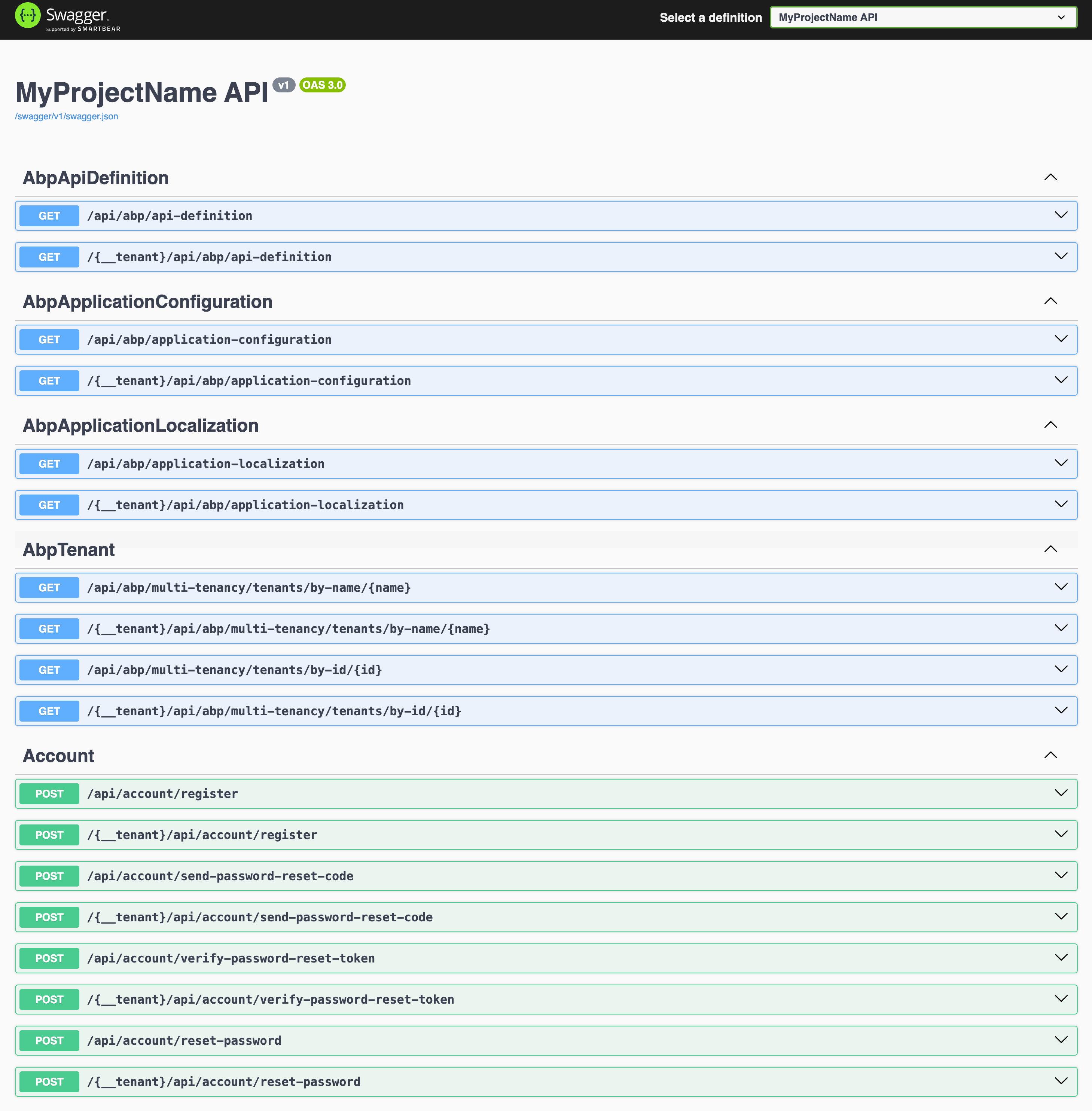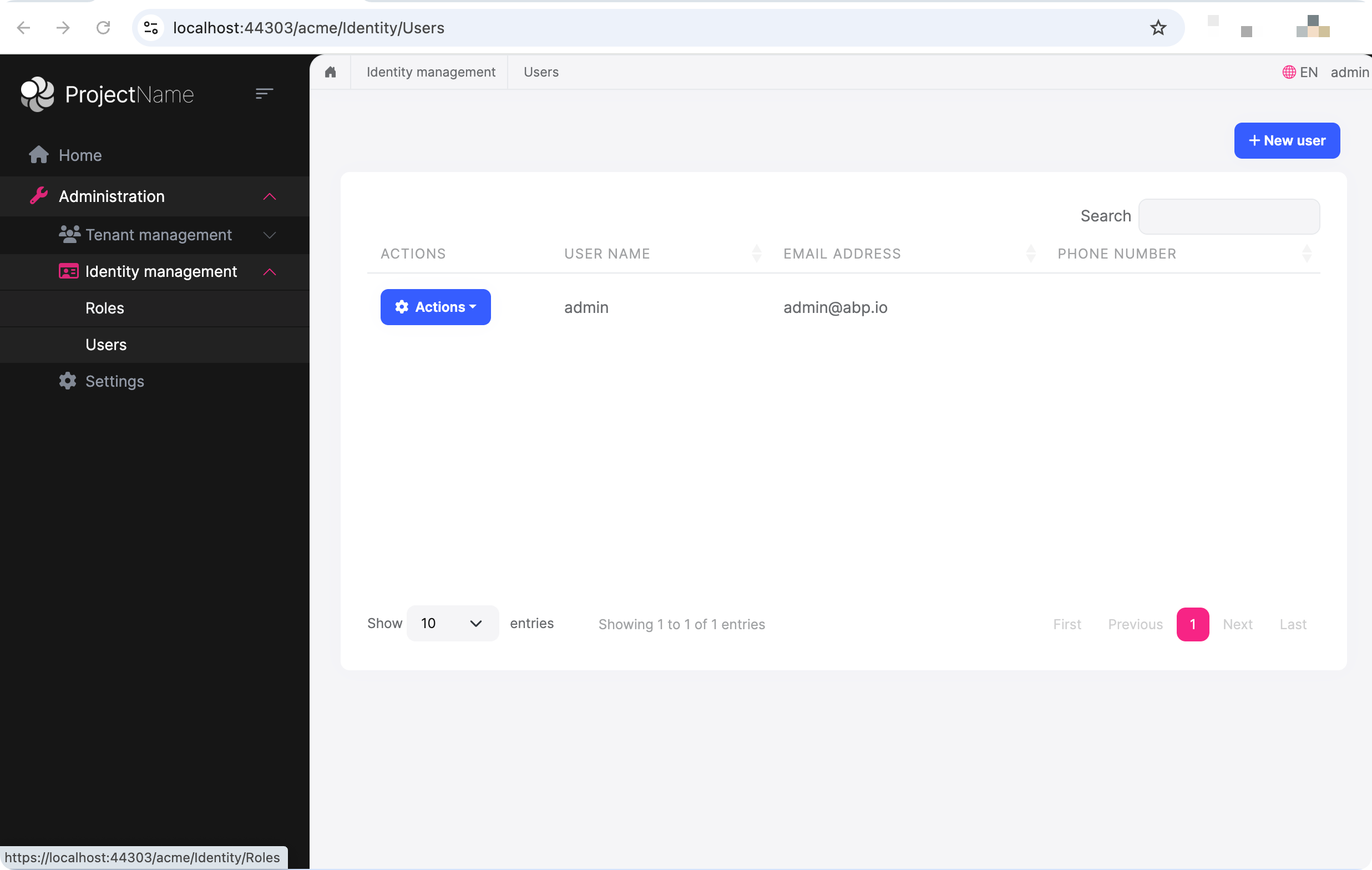Resolving Tenant from Route in ABP Framework
The ABP Framework provides multi-tenancy support with various ways to resolve tenant information, including: Cookie, Header, Domain, Route, and more.
This article will demonstrate how to resolve tenant information from the route.
Tenant Information in Routes
In the ABP Framework, tenant information in routes is handled by the RouteTenantResolveContributor.
Let's say your application is hosted at https://abp.io and you have a tenant named acme. You can add the {__tenant} variable to your controller or page routes like this:
[Route("{__tenant}/[Controller]")]
public class MyController : MyProjectNameController
{
[HttpGet]
public IActionResult Get()
{
return Ok("Hello My Page");
}
}
@page "{__tenant?}/mypage"
@model MyPageModel
<html>
<body>
<h1>My Page</h1>
</body>
</html>
When you access https://abp.io/acme/my or https://abp.io/acme/mypage, ABP will automatically resolve the tenant information from the route.
Adding __tenant to Global Routes
While we've shown how to add {__tenant} to individual controllers or pages, you might want to add it globally to your entire application. Here's how to implement this:
using System;
using System.Collections.Generic;
using System.Linq;
using Microsoft.AspNetCore.Mvc.ApplicationModels;
namespace MyCompanyName;
public class AddTenantRouteToPages : IPageRouteModelConvention, IApplicationModelConvention
{
public void Apply(PageRouteModel model)
{
var selectorCount = model.Selectors.Count;
var selectorModels = new List<SelectorModel>();
for (var i = 0; i < selectorCount; i++)
{
var selector = model.Selectors[i];
selectorModels.Add(new SelectorModel
{
AttributeRouteModel = new AttributeRouteModel
{
Template = AttributeRouteModel.CombineTemplates("{__tenant:regex(^[a-zA-Z0-9]+$)}", selector.AttributeRouteModel!.Template!.RemovePreFix("/"))
}
});
}
foreach (var selectorModel in selectorModels)
{
model.Selectors.Add(selectorModel);
}
}
}
public class AddTenantRouteToControllers :IApplicationModelConvention
{
public void Apply(ApplicationModel application)
{
var controllers = application.Controllers;
foreach (var controller in controllers)
{
var selector = controller.Selectors.FirstOrDefault();
if (selector == null || selector.AttributeRouteModel == null)
{
controller.Selectors.Add(new SelectorModel
{
AttributeRouteModel = new AttributeRouteModel
{
Template = AttributeRouteModel.CombineTemplates("{__tenant:regex(^[[a-zA-Z0-9]]+$)}", controller.ControllerName)
}
});
controller.Selectors.Add(new SelectorModel
{
AttributeRouteModel = new AttributeRouteModel
{
Template = controller.ControllerName
}
});
}
else
{
var template = selector.AttributeRouteModel?.Template;
template = template.IsNullOrWhiteSpace() ? "{__tenant:regex(^[[a-zA-Z0-9]]+$)}" : AttributeRouteModel.CombineTemplates("{__tenant:regex(^[[a-zA-Z0-9]]+$)}", template.RemovePreFix("/"));
controller.Selectors.Add(new SelectorModel
{
AttributeRouteModel = new AttributeRouteModel
{
Template = template
}
});
}
}
}
}
Register the services:
public override void ConfigureServices(ServiceConfigurationContext context)
{
//...
PostConfigure<RazorPagesOptions>(options =>
{
options.Conventions.Add(new AddTenantRouteToPages());
});
PostConfigure<MvcOptions>(options =>
{
options.Conventions.Add(new AddTenantRouteToControllers());
});
// Configure cookie path to prevent authentication cookie loss
context.Services.ConfigureApplicationCookie(x =>
{
x.Cookie.Path = "/";
});
//...
}
After implementing this, you'll notice that all controllers in your Swagger UI will have the {__tenant} route added:

Handling Navigation Links
To ensure navigation links automatically include tenant information, we need to add middleware that dynamically adds the tenant to the PathBase:
public override void OnApplicationInitialization(ApplicationInitializationContext context)
{
//...
app.Use(async (httpContext, next) =>
{
var tenantMatch = Regex.Match(httpContext.Request.Path, "^/([^/.]+)(?:/.*)?$");
if (tenantMatch.Groups.Count > 1 && !string.IsNullOrEmpty(tenantMatch.Groups[1].Value))
{
var tenantName = tenantMatch.Groups[1].Value;
if (!tenantName.IsNullOrWhiteSpace())
{
var tenantStore = httpContext.RequestServices.GetRequiredService<ITenantStore>();
var tenantNormalizer = httpContext.RequestServices.GetRequiredService<ITenantNormalizer>();
var tenantInfo = await tenantStore.FindAsync(tenantNormalizer.NormalizeName(tenantName)!);
if (tenantInfo != null)
{
if (httpContext.Request.Path.StartsWithSegments(new PathString(tenantName.EnsureStartsWith('/')), out var matchedPath, out var remainingPath))
{
var originalPath = httpContext.Request.Path;
var originalPathBase = httpContext.Request.PathBase;
httpContext.Request.Path = remainingPath;
httpContext.Request.PathBase = originalPathBase.Add(matchedPath);
try
{
await next(httpContext);
}
finally
{
httpContext.Request.Path = originalPath;
httpContext.Request.PathBase = originalPathBase;
}
return;
}
}
}
}
await next(httpContext);
});
app.UseRouting();
app.MapAbpStaticAssets();
//...
}

After setting the PathBase, we need to add a custom tenant resolver to extract tenant information from the PathBase:
public class MyRouteTenantResolveContributor : RouteTenantResolveContributor
{
public const string ContributorName = "MyRoute";
public override string Name => ContributorName;
protected override Task<string?> GetTenantIdOrNameFromHttpContextOrNullAsync(ITenantResolveContext context, HttpContext httpContext)
{
var tenantId = httpContext.GetRouteValue(context.GetAbpAspNetCoreMultiTenancyOptions().TenantKey) ?? httpContext.Request.PathBase.ToString();
var tenantIdStr = tenantId?.ToString()?.RemovePreFix("/");
return Task.FromResult(!tenantIdStr.IsNullOrWhiteSpace() ? Convert.ToString(tenantIdStr) : null);
}
}
Register the MyRouteTenantResolveContributor with the ABP Framework:
public override void ConfigureServices(ServiceConfigurationContext context)
{
//...
Configure<AbpTenantResolveOptions>(options =>
{
options.TenantResolvers.Add(new MyRouteTenantResolveContributor());
});
//...
}
Modifying abp.appPath
public override void ConfigureServices(ServiceConfigurationContext context)
{
//...
context.Services.AddOptions<AbpThemingOptions>().Configure<IServiceProvider>((options, rootServiceProvider) =>
{
var currentTenant = rootServiceProvider.GetRequiredService<ICurrentTenant>();
if (!currentTenant.Name.IsNullOrWhiteSpace())
{
options.BaseUrl = currentTenant.Name.EnsureStartsWith('/').EnsureEndsWith('/');
}
});
context.Services.RemoveAll(x => x.ServiceType == typeof(IOptions<AbpThemingOptions>));
context.Services.Add(ServiceDescriptor.Scoped(typeof(IOptions<>), typeof(OptionsManager<>)));
//...
}
Browser console output:
> https://localhost:44303/acme/
> abp.appPath
> '/acme/'
Summary
By following these steps, you can implement tenant resolution from routes in the ABP Framework and handle navigation links appropriately. This approach provides a clean and maintainable way to manage multi-tenancy in your application.


























































Comments
Engincan Veske 33 weeks ago
Great article, thanks for sharing.
Liming Ma 33 weeks ago
Thanks
myomyinthan 32 weeks ago
if we want path like this acme.abp.io, which code filles should we change? Thanks
Liming Ma 32 weeks ago
hi
If you want to use the tenant name in a subdomain, please check https://github.com/abpframework/abp-samples/tree/master/DomainTenantResolver
SUHAIL ISMAIL 8 weeks ago
AbpThemingOptions doesnt have a BaseUrl. How can i set the abp.appPath dynamically?
Liming Ma 8 weeks ago
hi
Can you upgrade your abp package version to >= 9.3.0 The BaseUrl was introduced after 9.3.0 https://github.com/abpframework/abp/pull/22598
Thanks.
SUHAIL ISMAIL 8 weeks ago
Hi,
I completed the setup but abp.appPath is still showing "/" and the api calls are made with undefined in the place of tenant
Liming Ma 8 weeks ago
hi
Please create an issue and share the details of your problem.
https://github.com/abpframework/abp/issues/new
Thanks.